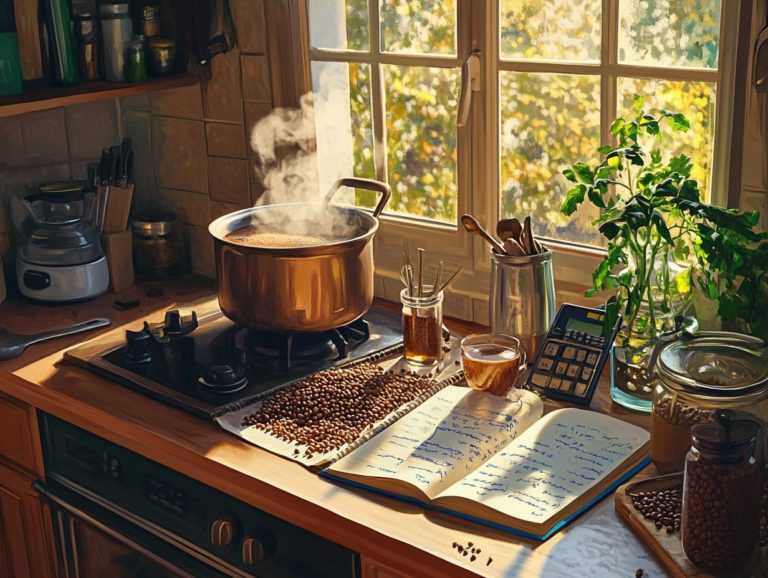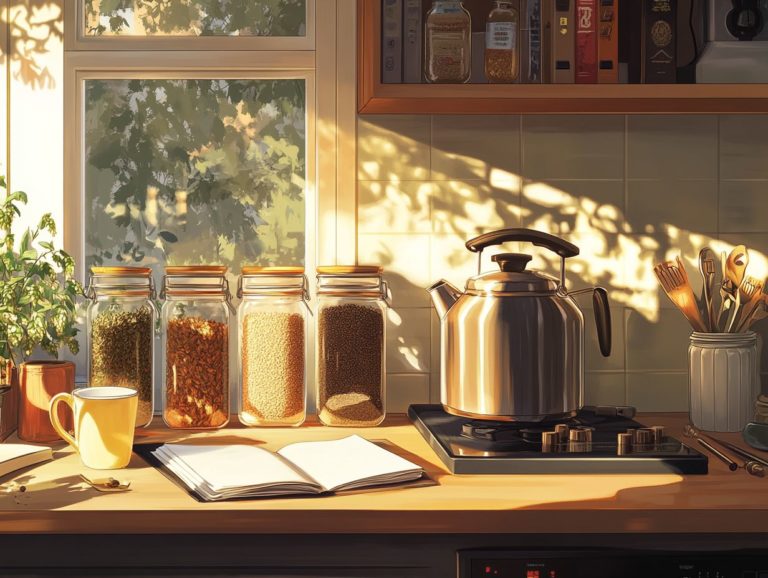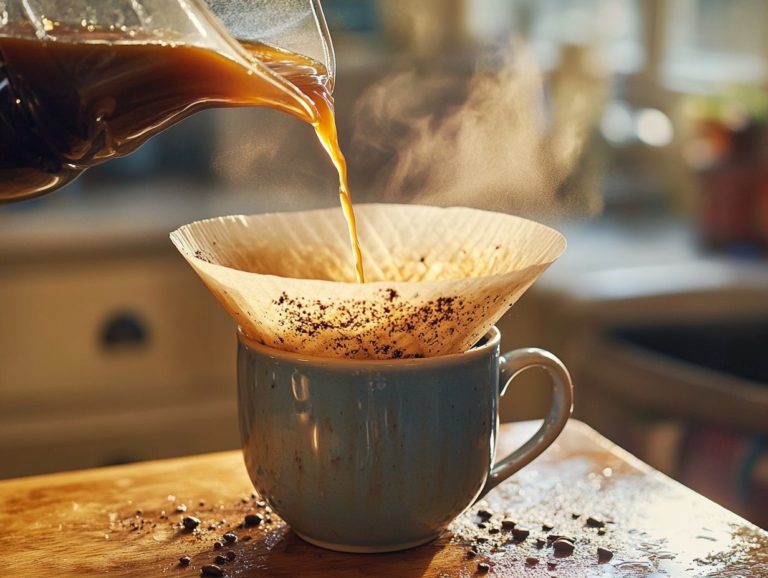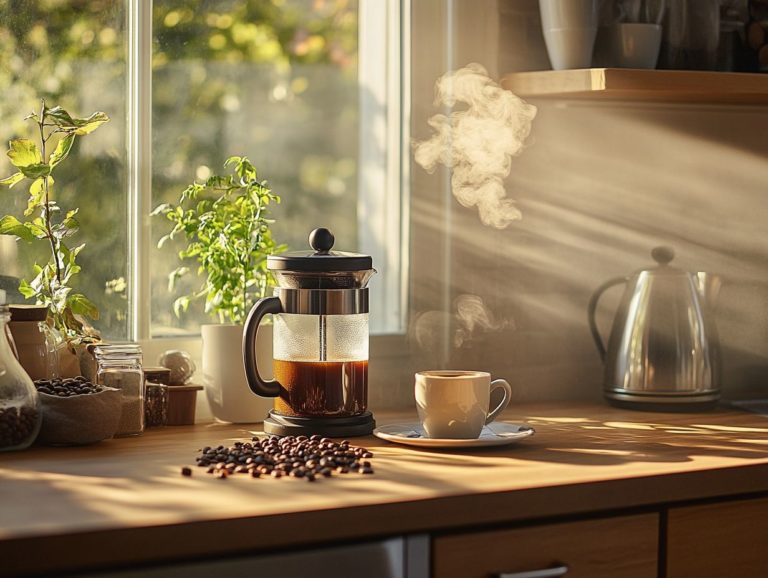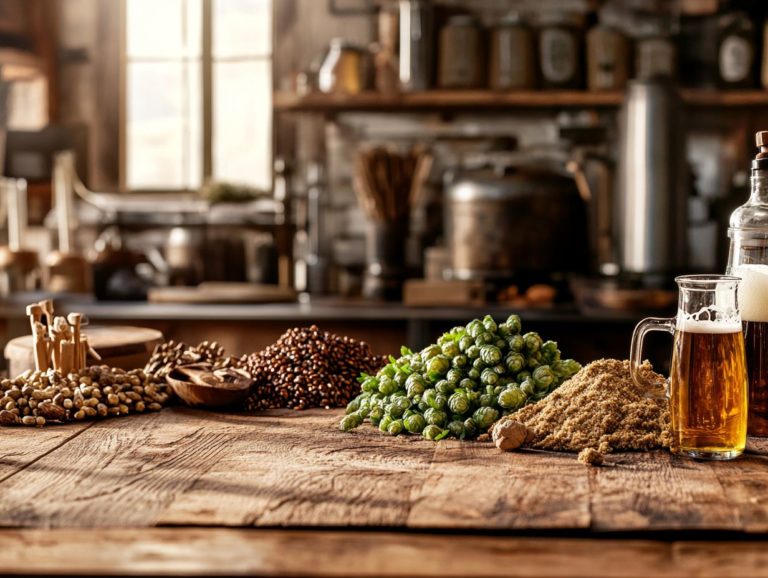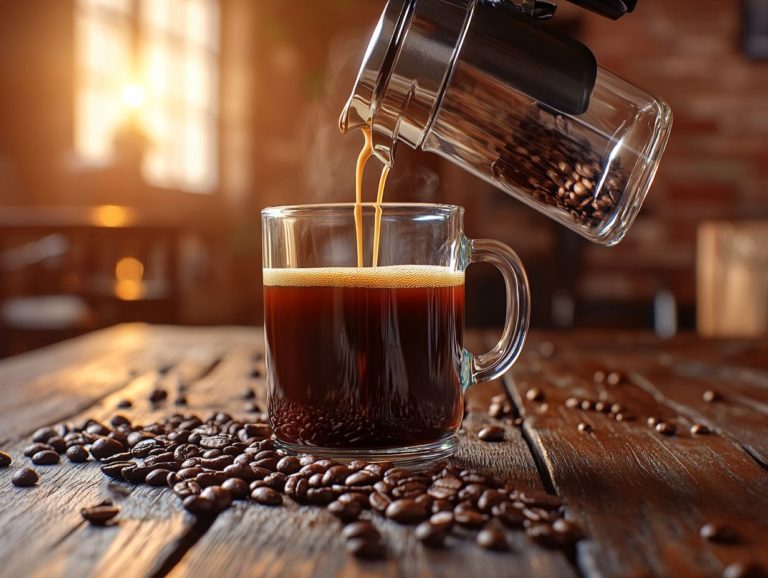Essential Brewing Techniques for Profound Flavor
Brewing the perfect cup of coffee or tea requires both art and science. Even tiny details can greatly affect the flavor.
This guide delves into essential brewing techniques that will elevate your beverage experience. It emphasizes crucial factors like water quality, grind size, and temperature.
Whether you prefer pour-over, French press, or espresso, the right brewing method can transform your coffee preparation. Discover methods to unlock deep, rich flavors while also identifying common pitfalls to avoid.
Whether you re just starting out or have years of experience under your belt, mastering these techniques will undoubtedly transform your brewing routine into something extraordinary. Dive into the world of coffee exploration and let your coffee journey lead you to new heights.
Contents
- Key Takeaways:
- The Importance of Brewing Techniques
- Factors That Affect Flavor in Brewing
- Water Quality
- Grind Size
- Water Temperature
- Coffee Brewing Techniques for Profound Flavor
- Essential Brewing Techniques for Flavorful Beer
- What are essential brewing techniques for achieving a profound flavor in beer?
- How does using quality ingredients impact the flavor of the beer?
- Why is controlling fermentation temperature important for achieving a profound flavor in beer?
- What is the role of water chemistry in brewing flavorful beer?
- Are there any specific brewing techniques that can enhance the flavor of certain beer styles?
- Can I achieve a profound flavor in my homebrewed beer without advanced brewing equipment?
Key Takeaways:
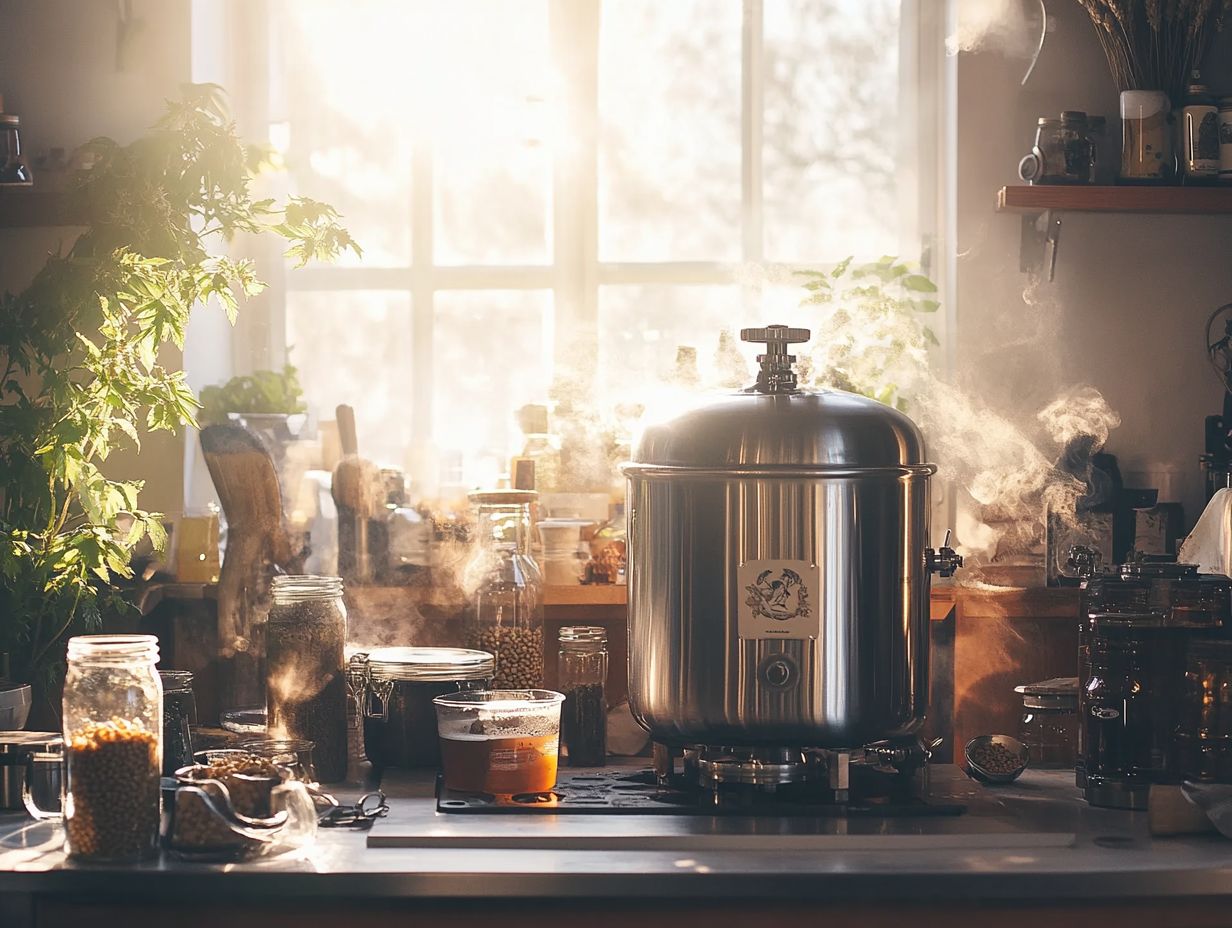
- Profound flavor in brewing begins with using freshly roasted beans, adjusting brewing time and temperature, and experimenting with different water sources. Engage with methods like AeroPress, Chemex, and auto-drip to expand your tasting experience.
- Water quality, grind size, and brewing time play crucial roles in achieving a delicious cup of coffee, so pay attention to these details in your brewing process.
- Avoid common mistakes like using old beans, inconsistent water temperature, and improper grind size to ensure the best flavor in your coffee. Keep your brewing equipment clean for optimal results.
The Importance of Brewing Techniques
Brewing techniques are essential in the realm of coffee, shaping the overall quality, flavor profile, and sensory experience of your final cup. Each method be it pour-over, French press, AeroPress, or espresso presents a distinct approach to extracting the rich flavors from coffee beans.
This invites you to embark on an exploration of your coffee journey through various brewing adventures. The method you choose can profoundly influence the aroma, acidity, sweetness, and balance of your cup.
It is crucial to grasp the nuances of different brewing techniques and their effects on your tasting experience as you engage with the vibrant coffee community. Participating in coffee competitions can also refine your brewing skills and broaden your appreciation for coffee culture.
Factors That Affect Flavor in Brewing
The flavor profile of brewed coffee is artfully shaped by a multitude of factors, each playing an essential role in the extraction process. The brew method you choose, the quality of the coffee beans you select, and key variables like water quality, grind size, water temperature, and brewing time intertwine to create a symphony of flavors.
By fine-tuning these elements, you can uncover a range of flavor notes and either elevate or temper the acidity, sweetness, and overall balance of your cup. Understanding how each of these factors contributes to your coffee enjoyment is vital for any true coffee enthusiast seeking an exceptional tasting experience.
Water Quality
Water quality stands as one of the most critical yet often overlooked factors in your coffee brewing journey. It significantly influences the flavor profile of your final cup. The purity of the water you use, along with its mineral content and any impurities, can dramatically alter the extraction process, impacting both the aroma and taste of your coffee.
For instance, opting for filtered or spring water can enhance the sweetness and balance of single-origin coffee. However, hard tap water might introduce undesirable bitterness. Don t overlook your water source it can make or break your coffee experience!
The relationship between water chemistry and brewing techniques is fundamental. Certain methods, such as espresso or pour-over, may require different water compositions to achieve the best results. Soft water may be perfect for a light brew, while a richer, more robust technique could benefit from harder water to create a fuller body.
To guarantee a consistently excellent cup, you should test your water for its pH and mineral balance. Making adjustments, such as adding minerals known to enhance extraction, can help counteract any drawbacks from subpar water quality. This kind of attention to detail not only elevates your overall coffee experience but also allows you to explore the intricate nuances of your favorite beans.
Coffee lovers flock to coffee shops to savor and explore different brewing methods! Understanding how different brewing methods interact with water quality can significantly enhance your tasting experience.
Grind Size
Grind size is a pivotal aspect of your coffee brewing process. It influences the extraction rate and shapes the flavor clarity of your brewed coffee. A coarser grind may be your best bet for French press brewing, as it helps extract flavors well during the longer brewing time. On the flip side, a finer grind is essential for espresso, which demands a quicker extraction process.
Understanding the relationship between grind size and brew method is crucial for anyone looking to master their brewing technique and achieve a balanced cup brimming with full-bodied flavor notes. Manual brewers like the Kalita Wave and Chemex allow for precise control over the brewing process, enhancing your coffee crafting experience.
For other brewing methods like pour-over or AeroPress, finding the right grind size can significantly enhance your tasting experience. A medium grind works wonders for pour-over, allowing hot water to flow evenly through the grounds and extract the nuanced flavors without tipping into over-extraction territory.
Fine-tuning your grind size is a crucial step towards coffee mastery. In contrast, a medium-fine grind is often recommended for Aeropress, striking a perfect balance between the speed of extraction and the depth of flavor.
By adjusting your grind size to suit each brewing method, you can tailor your beverages to highlight specific flavor profiles, achieving that perfect equilibrium between acidity, sweetness, and bitterness.
Water Temperature
Water temperature is crucial in the brewing process, influencing flavor extraction and your overall coffee enjoyment. The optimal brewing temperature typically hovers between 195 F and 205 F. This range allows for the efficient extraction of essential oils and flavor compounds present in your coffee.
If the water temperature is too high, you risk over-extraction, resulting in a bitter brew. Conversely, using water that s too cool can lead to under-extraction, leaving your coffee tasting flat and lifeless. Mastering the right water temperature is key to achieving a well-balanced cup that delights the palate.
Understanding how different brewing methods interact with water temperature can significantly elevate your tasting experience. For instance, methods like pour-over and AeroPress may require slight temperature adjustments compared to traditional drip coffee makers.
Each coffee variety boasts its unique flavor profile. By varying the temperature during brewing, you can accentuate specific tasting notes like fruity or floral undertones in lighter roasts while deeper, richer flavors emerge from darker blends. Therefore, experimenting within the ideal temperature range will unveil the delightful subtleties that make each cup a true pleasure.
Coffee recommendations from experienced baristas can guide you in exploring various roast levels and their optimal brewing temperatures.
Coffee Brewing Techniques for Profound Flavor
4. Brewing Time
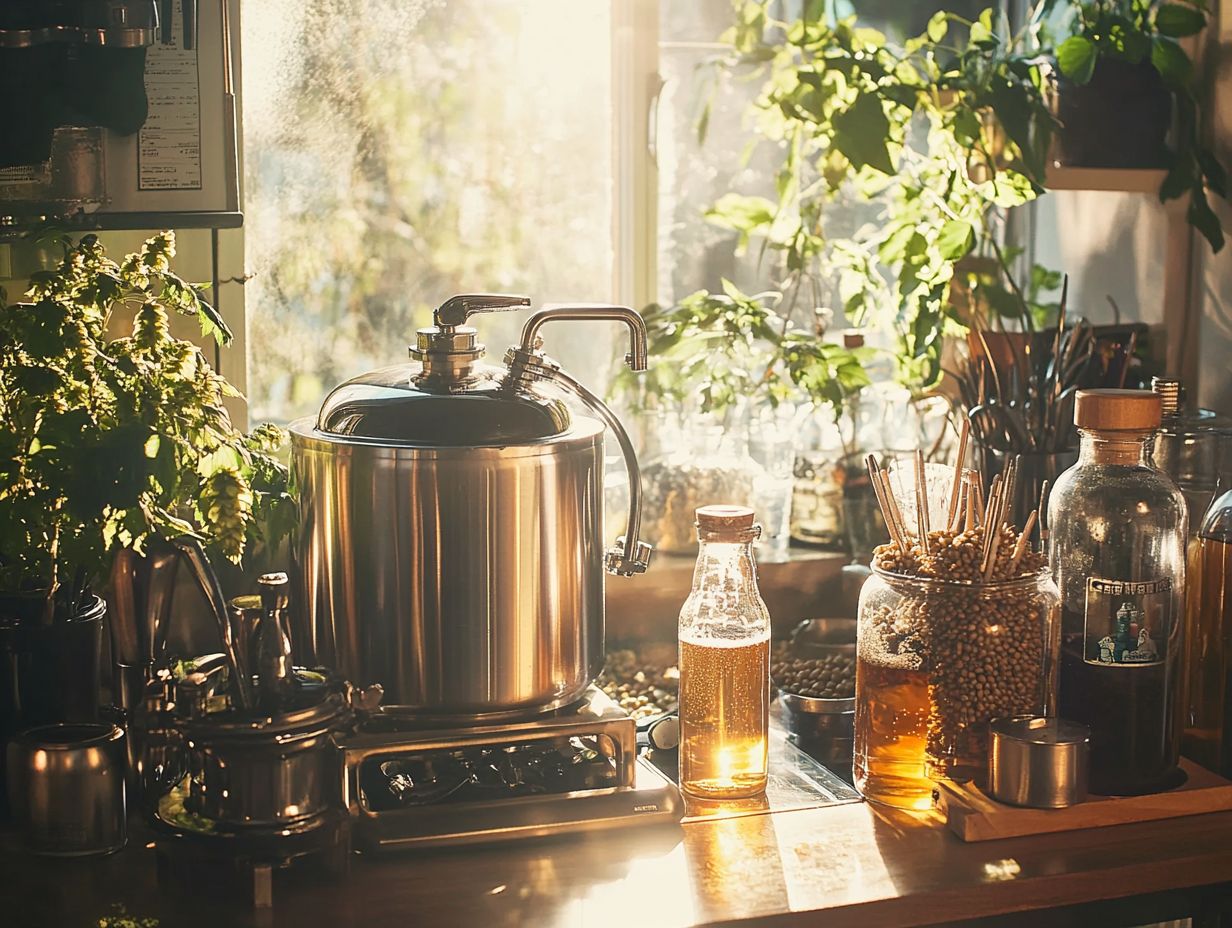
Brewing time is an essential element that significantly influences the extraction process. It ultimately shapes the flavor profile of your coffee. Each brewing method comes with its recommended brewing time. For instance, a pour-over typically requires 2-4 minutes, while a French press may take around 4 minutes.
If your brewing time is too short, your cup might lack depth and character. On the other hand, if you over-brew, you risk over-extraction, resulting in undesirable bitterness. By understanding the ideal brewing times for different methods, you can refine your coffee crafting skills and elevate your tasting experience.
Factors like grind size the coarseness or fineness of your coffee grounds and the type of coffee bean can also impact how flavor compounds are extracted during brewing. For example, coarsely ground beans used in a French press may require slightly longer brewing times to achieve that desired richness. In contrast, finely ground coffee for an espresso machine demands precision and swift extraction to avoid bitterness.
Experimenting with various brewing times and adjusting them according to your taste preferences can help you uncover the nuanced flavors and aromas that each type of coffee bean has to offer. This level of customization not only enhances your overall experience but also deepens your appreciation for the art of coffee brewing. Your coffee passion will lead you to greater coffee enjoyment and mastery of the coffee elixir.
How to Achieve a Profound Flavor in Brewing
Achieving a rich, profound flavor in your coffee brewing journey requires a meticulous balance of key elements. Each step from selecting the freshest coffee beans to the final brew must be executed with precision.
Begin with freshly roasted beans. Pay careful attention to the grind size and optimal brewing ratios, as these choices can significantly enhance the flavor profile and aroma of your coffee.
Next, explore different methods such as the Chemex, AeroPress, or French press. Each technique offers unique tasting experiences, allowing you to fully appreciate the complexity and richness of your brew. Engaging with the coffee community and participating in coffee competitions can also sharpen your tasting skills and deepen your appreciation for coffee varieties.
1. Use Freshly Roasted Beans
Using freshly roasted beans is essential for achieving a rich and vibrant flavor profile in your brewed coffee. Freshly roasted coffee beans retain the vital oils and compounds that enhance the overall aroma and taste, providing a satisfying sensory experience compared to stale counterparts.
Exploring different coffee varieties, such as single-origin beans, allows you to discover unique flavor notes that can elevate your brewing journey. It is crucial for coffee enthusiasts to prioritize freshness when selecting beans. Coffee shops often offer a range of single-origin options that highlight different flavor profiles, helping you refine your coffee preparation techniques.
To ensure you re choosing the freshest options available, always check for roast dates on the packaging. Aim to buy beans roasted within the last two weeks. A good rule of thumb is to avoid any beans that have been sitting on the shelf for too long, as they inevitably lose their vibrant flavors and delightful aromas over time.
Understanding the various roast levels light, medium, and dark can greatly influence your coffee s flavor profile and caffeine content. Lighter roasts typically offer more acidity and nuanced flavors, while darker roasts deliver richer, bolder experiences that can awaken your taste buds.
If you re in search of high-quality roasted beans, turn to reputable coffee shops and local roasters like Stumptown Coffee Roasters and Intelligentsia. They are celebrated for their commitment to freshness and excellence, ensuring you can savor every cup to the fullest.
Start your coffee brewing adventure now! Experiment with these techniques and discover your perfect cup.
2. Grind the Beans Just Before Brewing
Grinding your coffee beans just before brewing is an essential step in maximizing flavor and preserving the integrity of the coffee s aromatic profile. When you grind coffee fresh, it releases those precious essential oils and aromatic compounds that contribute to the coffee’s aroma and flavor, resulting in a cup that s more robust and flavorful.
This practice is crucial for coffee aficionados like yourself who want to explore the full spectrum of flavors in their brews. The grind size has a direct impact on the extraction process.
For instance, if you re using a French press, a coarser grind is your best bet; it allows for a slower extraction and helps prevent over-extraction, leading to a smoother taste. This brew method captures the essence of the beans, making it a favorite among manual brewers.
On the other hand, when it comes to espresso, you ll need a fine grind to generate the necessary pressure for a rich, dense crema and concentrated flavor.
Pour-over methods typically require a medium grind, striking a balance that promotes optimal extraction while allowing those bright notes to shine through. The Kalita Wave and Chemex are perfect examples of pour-over equipment.
By adjusting your grind size according to your chosen brewing method, you can unlock distinct taste profiles and elevate your coffee experience to new heights!
3. Experiment with Different Water Sources
Experimenting with various water sources can unveil fascinating nuances in flavor and elevate your overall coffee enjoyment. The mineral content and quality of water play a crucial role in the extraction process, significantly influencing the final taste of your brew.
Using filtered water, spring water, or specific bottled options allows you to discover different flavor profiles that encourage you to step outside your usual water choices.
To get started, conduct a simple taste test with different types of water. Sample tap water, bottled mineral water, and filtered options to discover which one best complements your coffee. Take notes during each test, honing in on aspects like acidity, sweetness, and body.
This practice will help you identify your preferred water sources and provide insights into how different minerals interact with various coffee beans.
Once you ve pinpointed your favorite water, integrating it into your regular brewing routine can consistently elevate your coffee experience, transforming each cup into an even more enjoyable ritual. This step is essential in the coffee journey towards mastering your brew.
4. Adjust Brewing Time and Temperature
Adjusting your brewing time and water temperature is essential for controlling the extraction process and highlighting specific flavor notes in your cup of coffee. Each brewing method comes with its own set of parameters, and even the slightest adjustments can lead to remarkably different outcomes.
For example, a longer brewing time at a lower temperature may enhance sweetness and acidity, while higher temperatures with shorter brewing times can extract bolder flavors and different flavor notes.
This makes it crucial for you, as a coffee enthusiast, to experiment with these variables to achieve your preferred taste.
To effectively tailor these elements, it s advisable for you to start keeping a detailed brewing journal. This log will help you track your brewing ratios and refine your techniques.
In this journal, meticulously record the specific parameters you use, such as water temperature, brew time, and the method applied, along with your tasting notes.
Over time, you ll begin to notice patterns that help refine your techniques and uncover your personalized flavor profiles, contributing to your coffee mastery.
Even minor adjustments like a 5-degree change in temperature or an extra minute in brewing can reveal entirely new dimensions of flavor. This journey is all part of the adventure in mastering the art of coffee brewing.
5. Try Different Brewing Methods
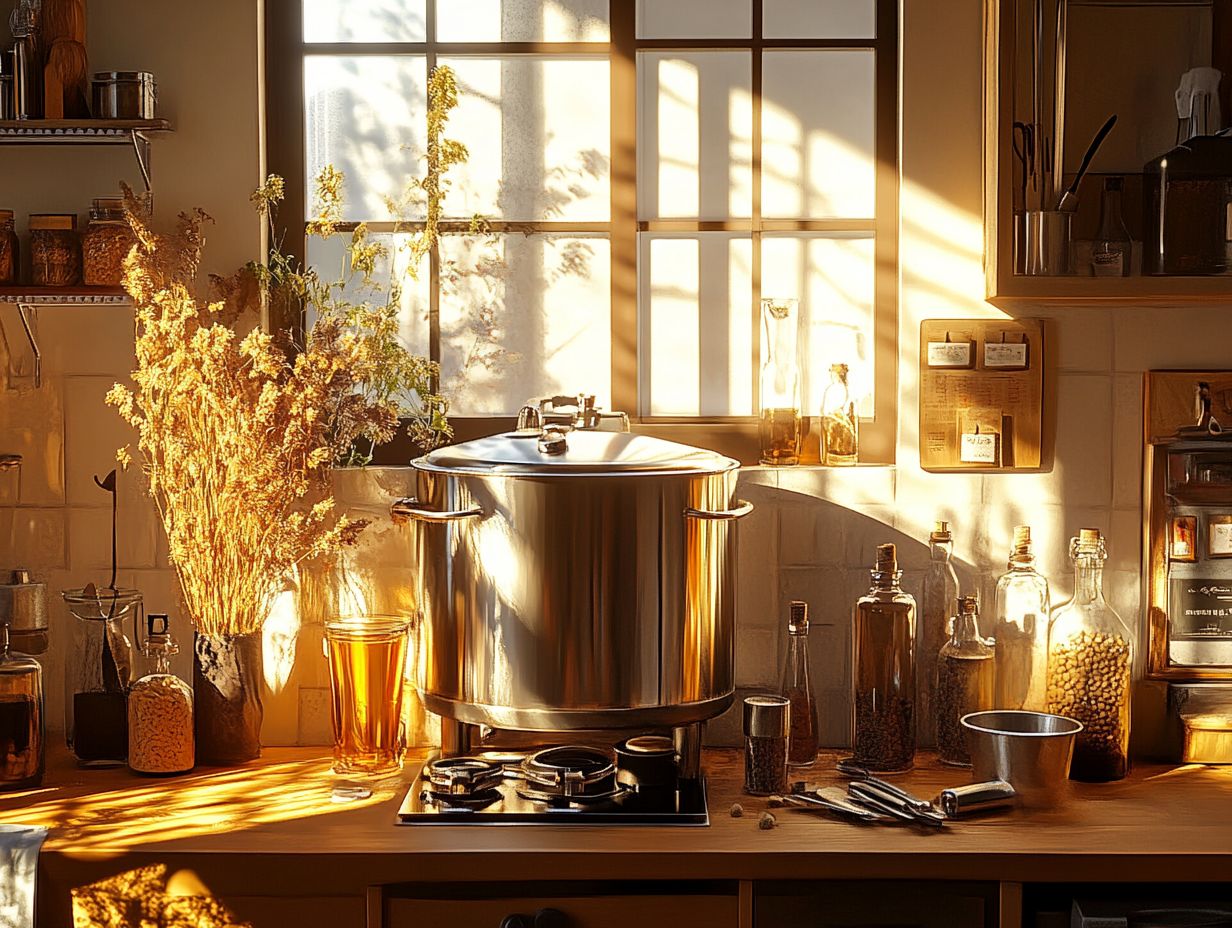
Exploring various brewing methods can dramatically transform the flavor profile of your coffee. It can elevate your entire brewing experience.
Techniques like pour-over, French press, AeroPress, and auto-drip each come with their own set of advantages, resulting in a delightful array of flavor extractions.
Take the pour-over method, for instance. It grants you precise control over water temperature and flow, allowing the coffee’s intricate flavors and aromas to shine through.
The French press serves up a robust and full-bodied cup, thanks to its soaking the coffee grounds in water that expertly extracts the oils and fine particles from the grounds.
The AeroPress, on the other hand, is your ticket to versatility and speed. It produces a rich coffee with a unique texture that you can easily adjust to suit your personal taste.
And let s not forget auto-drip machines, which offer the ultimate convenience for those who prefer consistency without the hassle.
Dive into these different brewing techniques and share your discoveries with a vibrant community that celebrates coffee!
Common Mistakes to Avoid in Brewing
Avoiding common mistakes in brewing is crucial for any coffee lover seeking to elevate their coffee preparation and achieve an exquisite flavor profile. Many enthusiasts tend to overlook key aspects of the brewing process, such as using old or stale beans, selecting improper grind sizes, or neglecting to clean their brewing equipment.
These missteps can result in undesirable flavors and a lackluster tasting experience, highlighting the necessity of grasping each element of the brewing techniques.
1. Using Old or Stale Beans
Using old or stale coffee beans is one of the most significant blunders you can make, as it can drastically diminish the flavor profile and aroma of your brew. Coffee beans start losing their vibrant oils and essential compounds shortly after roasting.
For true coffee enthusiasts like yourself, sourcing quality, freshly roasted beans is crucial to preserving those intended flavor notes.
Consider exploring single-origin coffee to understand the unique characteristics of different regions.
To maintain the rich essence of each cup, it s essential to know how to spot old coffee. Common signs of staleness include a noticeable loss of aroma, a flat taste, and an absence of complexity in the flavor profile.
Consume your beans within two to four weeks post-roasting for optimal freshness. When sourcing your coffee, consider purchasing from local roasters who emphasize quality and transparency in their practices.
- Look for roasters that proudly display roast dates on their packaging. This will help you ensure that your beans are as fresh as possible.
- Opt for whole beans instead of pre-ground options. Grinding accelerates staling and diminishes flavor retention.
Common Coffee Brewing Mistakes
2. Using Improper Grind Size
Using an improper grind size can significantly impact your extraction process, resulting in undesirable flavors and a muddled final brew. Each brewing method demands a specific grind size to maximize the flavors drawn out from the coffee grounds.
For instance, a coarse grind is perfect for a French press, while a fine grind is essential for crafting the ideal espresso. By understanding the relationship between grind size and brewing method, you can elevate your coffee-making skills and achieve the flavor clarity you desire.
For techniques like pour-over or drip coffee, a medium grind size is your sweet spot. Using a balanced brewing ratio is also essential to achieving the perfect cup.
A balanced brewing ratio allows water to flow evenly through the grounds, extracting a wide range of flavors without leading to over-extraction. On the flip side, opting for a grind that’s too fine can lead to bitterness from over-extraction, while a grind that’s too coarse may leave you with a weak and lackluster cup.
It’s also crucial to experiment with your equipment and water temperatures, as these factors can greatly influence the overall taste and extraction process. Doing so can help unveil the rich, aromatic nuances that each coffee bean has to offer, transforming your brewing experience into something truly exceptional.
3. Inconsistent Water Temperature
Inconsistent water temperature during brewing can lead you down a path of uneven extraction, leaving your coffee lacking balance and ultimately unsatisfactory. Maintaining the right temperature is crucial, as it directly influences the extraction of different flavor compounds in your coffee. Temperatures that are too high or too low can yield undesirable flavors.
As a coffee enthusiast, it s essential to invest in quality brewing equipment with precise temperature control. This investment unlocks the optimal flavor extraction. Exploring various brewing methods can also enhance your coffee journey, helping you find the perfect technique for your taste.
Using a thermometer can be a game-changer for monitoring water temperature, ensuring it stays within that ideal range of 195 F to 205 F (90 C to 96 C). Preheating your brewing vessel can stabilize the temperature during extraction, further enhancing your results.
Consider the water quality, as it can significantly impact the overall flavor profile of your coffee. Opting for a kettle with temperature settings, whether electric or stovetop, offers you the precision needed to reach and maintain that perfect brewing temperature.
Embrace these practices to elevate your coffee-making skills and enjoy every sip! Savor a consistently rich and flavorful cup that truly highlights the unique qualities of the coffee beans. Achieving a single-origin coffee can further enhance your flavor notes and tasting experience.
4. Achieving the Perfect Coffee Extraction
Understanding the extraction process is essential for achieving your ideal flavor profile.
Over-extracting or under-extracting coffee is a common pitfall that can significantly impact the flavor and overall enjoyment of your brew. When you over-extract, bitterness often creeps in. Under-extraction can leave you with a weak and sour concoction. It s crucial for coffee lovers like you to strike that perfect balance.
Paying attention to brewing time and grind size helps you find the right balance. By focusing on these factors, along with water temperature and other variables, you can achieve optimal extraction, resulting in a rich and satisfying coffee experience.
To master this balance, it s essential to grasp the science behind coffee extraction. Over-extraction happens when you prolong the brewing process or use water that s too hot, causing unwanted bitter compounds to seep out, potentially ruining your otherwise enjoyable coffee experience.
On the flip side, under-extraction occurs when your coffee grounds are deprived of enough water contact or if the temperature is too low, resulting in a bland, lackluster flavor profile.
Explore different brewing methods like French press or pour-over to elevate your coffee crafting experience! Each method calls for specific adjustments in time and temperature to fine-tune the extraction. Understanding your chosen brewing method can make a huge difference.
Don t shy away from experimenting with grind size; it plays a crucial role in surface area, which refers to how much of the coffee grind is exposed, influencing the extraction. Each brewing method may require a different grind size, so feel free to experiment with manual brewers like the French Press or Chemex to find what works best for you. With a little trial and error, you ll be able to relish a perfectly balanced cup every time.
5. Not Cleaning Brewing Equipment Properly
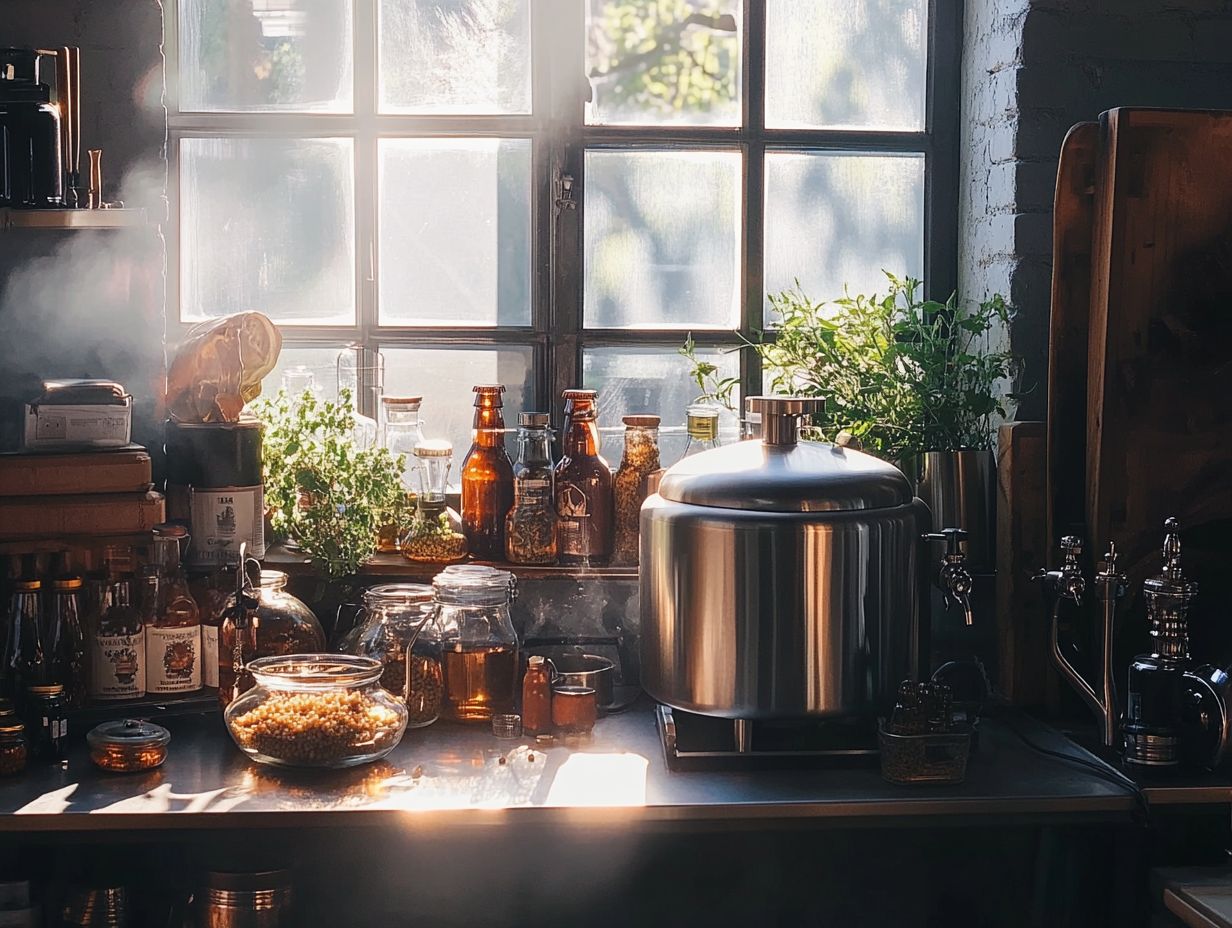
Neglecting to clean your brewing equipment properly can result in residual flavors and oils that compromise the purity of your coffee, ultimately impacting the flavor profile of each cup. Regular maintenance and cleaning of your coffee makers, grinders, and other brewing tools are essential for anyone who desires a consistent and high-quality brew.
This basic but vital part of coffee preparation ensures that you get the full-bodied coffee experience every time. By prioritizing cleanliness in your coffee preparation process, you ensure that each cup truly reflects the essence of the coffee beans you ve chosen. This routine is a must for serious coffee enthusiasts who are passionate about their coffee journey and the craft of brewing.
Implementing proper cleaning routines not only enhances flavor integrity but also extends the lifespan of your equipment. After each use, make it a priority to rinse out coffee pots and brew baskets to eliminate any lingering coffee grounds and oils. This keeps your brewing equipment in prime condition, ensuring the flavor clarity of your next brew.
Regarding grinders, a monthly deep clean using specialized cleaning tablets will help remove buildup and maintain a consistent grind size. Don t forget to periodically descale your machines, especially those that use water, to prevent mineral deposits from marring your coffee experience. Descaling is a crucial part of detailed brewing and ensures a prolonged lifespan for your equipment.
By adopting a systematic cleaning approach, you will guarantee that every cup of coffee delivers the full spectrum of flavors that freshly brewed coffee has to offer. This commitment to cleanliness is part of the broader coffee culture and reflects your coffee passion.
Frequently Asked Questions
How do brewing ratios impact the flavor profile of coffee?
Brewing ratios are essential because they determine how strong and flavorful your coffee will be. Adjusting the coffee-to-water ratio helps you achieve your ideal taste.
Ready to take your coffee brewing to the next level? Start experimenting with these techniques and share your experiences!
Essential Brewing Techniques for Flavorful Beer
What are essential brewing techniques for achieving a profound flavor in beer?
Some essential brewing techniques for achieving a profound flavor in beer include selecting quality ingredients and controlling fermentation temperatures. Understanding water chemistry is equally vital.
These principles apply to coffee brewing as well, where methods like pour-over or AeroPress can enhance your tasting experience.
How does using quality ingredients impact the flavor of the beer?
Using high-quality ingredients such as fresh hops and specialty malts can greatly enhance the flavor of the beer. These ingredients contribute unique flavors and aromas that cannot be replicated with lower-quality ingredients.
Similarly, choosing high-quality coffee beans can significantly impact your flavor profile.
Why is controlling fermentation temperature important for achieving a profound flavor in beer?
Fermentation temperature plays a crucial role in the flavor development of beer. By controlling the temperature, you can ensure that the yeast is working at its optimal level, producing the desired flavors and aromas in the beer.
In the world of coffee, maintaining the correct brewing temperature is equally crucial for achieving the desired flavor notes.
What is the role of water chemistry in brewing flavorful beer?
Water chemistry can greatly impact the flavor of beer. Different levels of minerals and pH levels can affect the bitterness, body, and overall taste of the beer.
Understanding water chemistry and making adjustments can help create a more balanced and flavorful brew. This principle also applies to coffee, where water quality significantly influences the flavor profile.
Are there any specific brewing techniques that can enhance the flavor of certain beer styles?
Yes, there are certain brewing techniques that work best for specific beer styles. For example, dry hopping (adding hops late in the brewing process for aroma) is commonly used in IPAs to add a burst of hop flavor and aroma.
On the other hand, decoction mashing (a method of mashing that involves boiling part of the mash) is often used for traditional German lagers to create a unique malty flavor.
Similarly, specific brewing techniques like using a Kalita Wave or Chemex can enhance the flavor of certain coffee varieties.
Can I achieve a profound flavor in my homebrewed beer without advanced brewing equipment?
Absolutely! While having advanced brewing equipment can certainly make the process easier, there are still plenty of techniques that can be used to achieve a profound flavor in homebrewed beer.
Just be sure to thoroughly research and understand the techniques you are using.
The same goes for coffee; even without advanced equipment, understanding basic brewing techniques can significantly enhance your coffee enjoyment.
Don t wait! Start brewing today and discover profound flavors!

